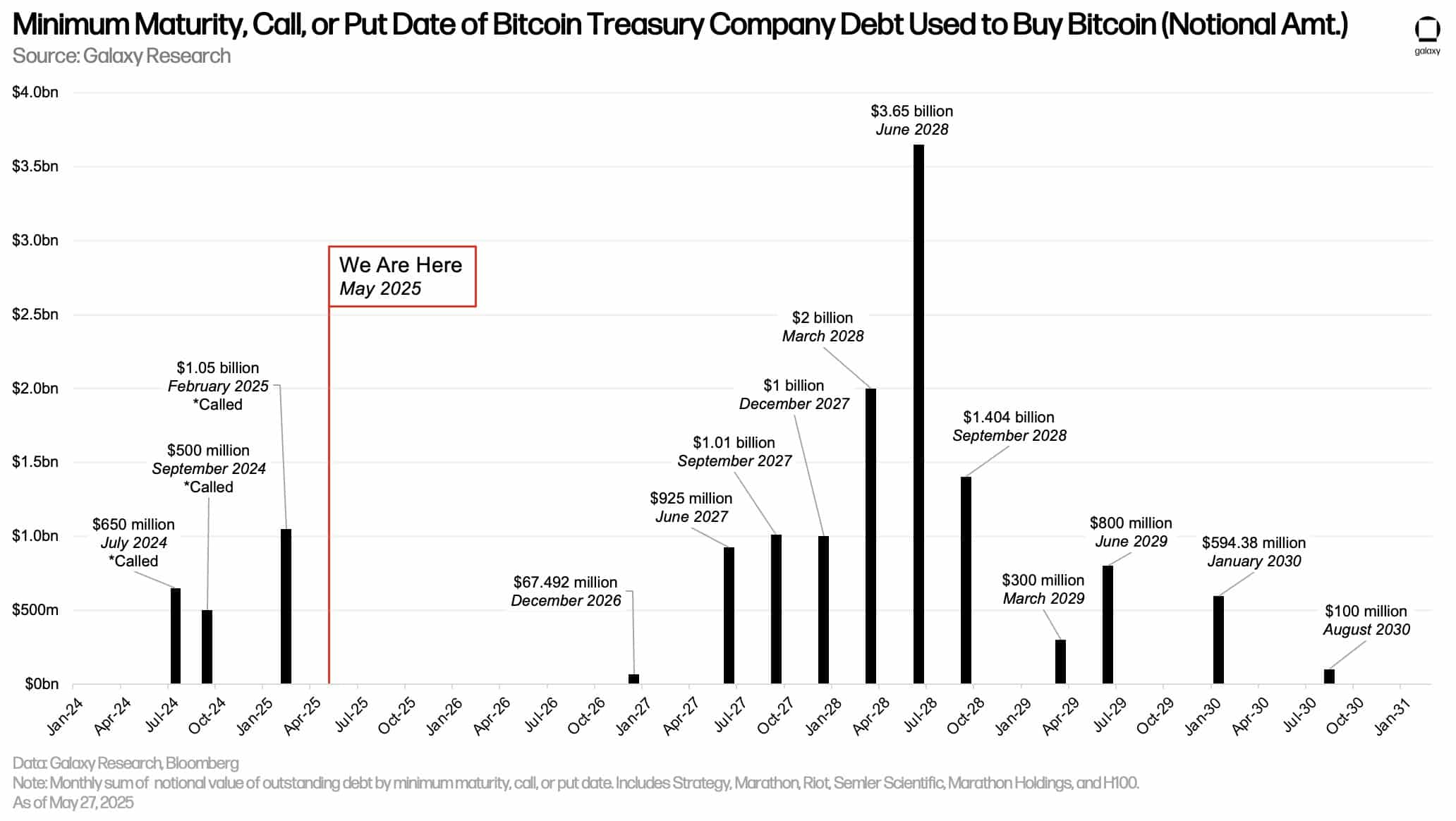| COINOTAG recommends • Exchange signup |
| 💹 Trade with pro tools |
| Fast execution, robust charts, clean risk controls. |
| 👉 Open account → |
| COINOTAG recommends • Exchange signup |
| 🚀 Smooth orders, clear control |
| Advanced order types and market depth in one view. |
| 👉 Create account → |
| COINOTAG recommends • Exchange signup |
| 📈 Clarity in volatile markets |
| Plan entries & exits, manage positions with discipline. |
| 👉 Sign up → |
| COINOTAG recommends • Exchange signup |
| ⚡ Speed, depth, reliability |
| Execute confidently when timing matters. |
| 👉 Open account → |
| COINOTAG recommends • Exchange signup |
| 🧭 A focused workflow for traders |
| Alerts, watchlists, and a repeatable process. |
| 👉 Get started → |
| COINOTAG recommends • Exchange signup |
| ✅ Data‑driven decisions |
| Focus on process—not noise. |
| 👉 Sign up → |
-
Bitcoin treasury companies hold a substantial $12.7 billion in outstanding debt, with Strategy alone responsible for $8.2 billion, raising concerns about potential market impacts.
-
Despite these figures, Galaxy Digital’s Head of Research, Alex Thorn, has reassured investors that fears surrounding debt maturities are premature, as most obligations will not come due until 2027-2030.
-
According to COINOTAG, “Bitcoin treasury companies won’t prevent another bear market; they’re the reason it’ll happen again this cycle,” highlighting the ongoing debate about the influence of these firms on market cycles.
Bitcoin treasury firms carry $12.7B debt, with Strategy holding $8.2B; Galaxy Digital downplays risks, citing debt maturity from 2027 onward amid market concerns.
Bitcoin Treasury Firms’ $12.7 Billion Debt and Market Implications
The growing debt load of Bitcoin treasury companies has become a focal point for analysts and investors alike. Strategy, formerly known as MicroStrategy, leads with an outstanding debt of $8.2 billion used primarily to acquire its 580,900 BTC holdings. Collectively, these treasury firms hold approximately 3.65% of the total Bitcoin supply, a significant stake that could influence market dynamics in the event of financial distress.
While some market participants argue that these companies could exacerbate a future bear market, others suggest they might stabilize Bitcoin demand by driving substantial inflows. Bernstein analysts forecast that treasury firms could contribute over $330 billion in Bitcoin purchases by 2029, potentially supporting price floors during downturns. However, skepticism remains regarding the resilience of newer entrants compared to Strategy’s historically disciplined approach.
Debt Maturity Timeline and Risk Assessment
Galaxy Digital’s research provides a nuanced perspective on the debt concerns. Alex Thorn emphasized that the majority of Strategy’s debt obligations are scheduled to mature between 2027 and 2030, mitigating immediate refinancing risks. This timeline suggests that while the debt is sizable, it does not pose an imminent threat to Bitcoin’s price stability or market health.
| COINOTAG recommends • Professional traders group |
| 💎 Join a professional trading community |
| Work with senior traders, research‑backed setups, and risk‑first frameworks. |
| 👉 Join the group → |
| COINOTAG recommends • Professional traders group |
| 📊 Transparent performance, real process |
| Spot strategies with documented months of triple‑digit runs during strong trends; futures plans use defined R:R and sizing. |
| 👉 Get access → |
| COINOTAG recommends • Professional traders group |
| 🧭 Research → Plan → Execute |
| Daily levels, watchlists, and post‑trade reviews to build consistency. |
| 👉 Join now → |
| COINOTAG recommends • Professional traders group |
| 🛡️ Risk comes first |
| Sizing methods, invalidation rules, and R‑multiples baked into every plan. |
| 👉 Start today → |
| COINOTAG recommends • Professional traders group |
| 🧠 Learn the “why” behind each trade |
| Live breakdowns, playbooks, and framework‑first education. |
| 👉 Join the group → |
| COINOTAG recommends • Professional traders group |
| 🚀 Insider • APEX • INNER CIRCLE |
| Choose the depth you need—tools, coaching, and member rooms. |
| 👉 Explore tiers → |
Nonetheless, experts like Geoffrey Kendrick of Standard Chartered caution that these treasury companies could become sources of volatility if market conditions deteriorate. The potential for forced asset sales or refinancing challenges remains a risk factor to monitor, especially as the crypto market matures and external economic pressures evolve.

| COINOTAG recommends • Exchange signup |
| 📈 Clear interface, precise orders |
| Sharp entries & exits with actionable alerts. |
| 👉 Create free account → |
| COINOTAG recommends • Exchange signup |
| 🧠 Smarter tools. Better decisions. |
| Depth analytics and risk features in one view. |
| 👉 Sign up → |
| COINOTAG recommends • Exchange signup |
| 🎯 Take control of entries & exits |
| Set alerts, define stops, execute consistently. |
| 👉 Open account → |
| COINOTAG recommends • Exchange signup |
| 🛠️ From idea to execution |
| Turn setups into plans with practical order types. |
| 👉 Join now → |
| COINOTAG recommends • Exchange signup |
| 📋 Trade your plan |
| Watchlists and routing that support focus. |
| 👉 Get started → |
| COINOTAG recommends • Exchange signup |
| 📊 Precision without the noise |
| Data‑first workflows for active traders. |
| 👉 Sign up → |
Source: Galaxy
Market Sentiment and Strategic Responses from Industry Leaders
Industry voices remain divided on the long-term impact of treasury company debt on Bitcoin’s price trajectory. Max Keiser, a prominent Bitcoin advocate and advisor to El Salvador’s government, expressed skepticism about newer treasury firms replicating Strategy’s steadfast accumulation strategy, warning that less disciplined companies may succumb to market pressures.
| COINOTAG recommends • Traders club |
| ⚡ Futures with discipline |
| Defined R:R, pre‑set invalidation, execution checklists. |
| 👉 Join the club → |
| COINOTAG recommends • Traders club |
| 🎯 Spot strategies that compound |
| Momentum & accumulation frameworks managed with clear risk. |
| 👉 Get access → |
| COINOTAG recommends • Traders club |
| 🏛️ APEX tier for serious traders |
| Deep dives, analyst Q&A, and accountability sprints. |
| 👉 Explore APEX → |
| COINOTAG recommends • Traders club |
| 📈 Real‑time market structure |
| Key levels, liquidity zones, and actionable context. |
| 👉 Join now → |
| COINOTAG recommends • Traders club |
| 🔔 Smart alerts, not noise |
| Context‑rich notifications tied to plans and risk—never hype. |
| 👉 Get access → |
| COINOTAG recommends • Traders club |
| 🤝 Peer review & coaching |
| Hands‑on feedback that sharpens execution and risk control. |
| 👉 Join the club → |
Conversely, Galaxy Digital’s stance reflects confidence in the current debt structure, suggesting that the market has sufficient time to adapt to upcoming maturities. This perspective encourages investors to focus on fundamental Bitcoin adoption trends rather than short-term debt concerns.
Future Outlook: Monitoring Debt and Market Stability
As Bitcoin treasury companies continue to expand their holdings through leveraged debt, ongoing transparency and risk management will be critical. Investors and analysts should closely monitor debt maturity schedules, refinancing conditions, and broader macroeconomic factors that could influence these firms’ financial health.
Strategic debt management and disciplined accumulation remain key factors that could determine whether treasury companies act as stabilizers or catalysts for volatility in future market cycles.
Conclusion
While Bitcoin treasury companies hold significant debt, the majority of maturities are several years away, reducing immediate market risk. Industry experts offer mixed views, but Galaxy Digital’s analysis suggests current concerns may be overstated. Investors should remain vigilant, focusing on long-term fundamentals and the evolving strategies of treasury firms to navigate potential market fluctuations effectively.
| COINOTAG recommends • Exchange signup |
| 📈 Clear control for futures |
| Sizing, stops, and scenario planning tools. |
| 👉 Open futures account → |
| COINOTAG recommends • Exchange signup |
| 🧩 Structure your futures trades |
| Define entries & exits with advanced orders. |
| 👉 Sign up → |
| COINOTAG recommends • Exchange signup |
| 🛡️ Control volatility |
| Automate alerts and manage positions with discipline. |
| 👉 Get started → |
| COINOTAG recommends • Exchange signup |
| ⚙️ Execution you can rely on |
| Fast routing and meaningful depth insights. |
| 👉 Create account → |
| COINOTAG recommends • Exchange signup |
| 📒 Plan. Execute. Review. |
| Frameworks for consistent decision‑making. |
| 👉 Join now → |
| COINOTAG recommends • Exchange signup |
| 🧩 Choose clarity over complexity |
| Actionable, pro‑grade tools—no fluff. |
| 👉 Open account → |
| COINOTAG recommends • Members‑only research |
| 📌 Curated setups, clearly explained |
| Entry, invalidation, targets, and R:R defined before execution. |
| 👉 Get access → |
| COINOTAG recommends • Members‑only research |
| 🧠 Data‑led decision making |
| Technical + flow + context synthesized into actionable plans. |
| 👉 Join now → |
| COINOTAG recommends • Members‑only research |
| 🧱 Consistency over hype |
| Repeatable rules, realistic expectations, and a calmer mindset. |
| 👉 Get access → |
| COINOTAG recommends • Members‑only research |
| 🕒 Patience is an edge |
| Wait for confirmation and manage risk with checklists. |
| 👉 Join now → |
| COINOTAG recommends • Members‑only research |
| 💼 Professional mentorship |
| Guidance from seasoned traders and structured feedback loops. |
| 👉 Get access → |
| COINOTAG recommends • Members‑only research |
| 🧮 Track • Review • Improve |
| Documented PnL tracking and post‑mortems to accelerate learning. |
| 👉 Join now → |







